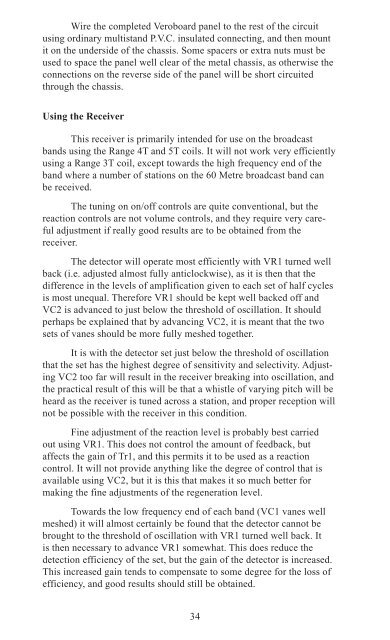Solid State Shortwave Receivers For Beginners - The Listeners Guide
Solid State Shortwave Receivers For Beginners - The Listeners Guide
Solid State Shortwave Receivers For Beginners - The Listeners Guide
You also want an ePaper? Increase the reach of your titles
YUMPU automatically turns print PDFs into web optimized ePapers that Google loves.
Wire the completed Veroboard panel to the rest of the circuit<br />
using ordinary multistand P.V.C. insulated connecting, and then mount<br />
it on the underside of the chassis. Some spacers or extra nuts must be<br />
used to space the panel well clear of the metal chassis, as otherwise the<br />
connections on the reverse side of the panel will be short circuited<br />
through the chassis.<br />
Using the Receiver<br />
This receiver is primarily intended for use on the broadcast<br />
bands using the Range 4T and 5T coils. It will not work very efficiently<br />
using a Range 3T coil, except towards the high frequency end of the<br />
band where a number of stations on the 60 Metre broadcast band can<br />
be received.<br />
<strong>The</strong> tuning on on/off controls are quite conventional, but the<br />
reaction controls are not volume controls, and they require very careful<br />
adjustment if really good results are to be obtained from the<br />
receiver.<br />
<strong>The</strong> detector will operate most efficiently with VR1 turned well<br />
back (i.e. adjusted almost fully anticlockwise), as it is then that the<br />
difference in the levels of amplification given to each set of half cycles<br />
is most unequal. <strong>The</strong>refore VR1 should be kept well backed off and<br />
VC2 is advanced to just below the threshold of oscillation. It should<br />
perhaps be explained that by advancing VC2, it is meant that the two<br />
sets of vanes should be more fully meshed together.<br />
It is with the detector set just below the threshold of oscillation<br />
that the set has the highest degree of sensitivity and selectivity. Adjusting<br />
VC2 too far will result in the receiver breaking into oscillation, and<br />
the practical result of this will be that a whistle of varying pitch will be<br />
heard as the receiver is tuned across a station, and proper reception will<br />
not be possible with the receiver in this condition.<br />
Fine adjustment of the reaction level is probably best carried<br />
out using VR1. This does not control the amount of feedback, but<br />
affects the gain of Tr1, and this permits it to be used as a reaction<br />
control. It will not provide anything like the degree of control that is<br />
available using VC2, but it is this that makes it so much better for<br />
making the fine adjustments of the regeneration level.<br />
Towards the low frequency end of each band (VC1 vanes well<br />
meshed) it will almost certainly be found that the detector cannot be<br />
brought to the threshold of oscillation with VR1 turned well back. It<br />
is then necessary to advance VR1 somewhat. This does reduce the<br />
detection efficiency of the set, but the gain of the detector is increased.<br />
This increased gain tends to compensate to some degree for the loss of<br />
efficiency, and good results should still be obtained.<br />
34

















